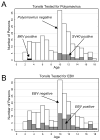Detection of polyomavirus SV40 in tonsils from immunocompetent children
- PMID: 18539521
- PMCID: PMC2584969
- DOI: 10.1016/j.jcv.2008.04.011
Detection of polyomavirus SV40 in tonsils from immunocompetent children
Abstract
Background: BK virus (BKV), JC virus (JCV) and simian virus 40 (SV40) are nonenveloped DNA viruses, members of the family Polyomaviridae. BK and JC viruses establish persistent infections in humans, and evidence suggests that SV40 can infect humans, as well. Whether persistence occurs in the lymphoid system is unknown.
Methods: Paraffin-embedded tonsils from 220 immunocompetent children (mean age 9.3 years) were examined by polymerase chain reaction (PCR) to detect viral DNA of BKV, JCV, SV40, and Epstein-Barr virus (EBV).
Results: Polyomavirus-specific DNA sequences were detected in 8.3% (29/351) of specimens collected from 220 children. Twenty-one (9.5%) children had polyomavirus DNA present in at least one tonsil, with sequences identified as SV40 (n=20) and BKV (n=1). Polyomavirus JCV was not detected. Among patients positive for SV40, 8 of 14 (57%) contained viral DNA in both available tonsils. EBV DNA was detected in 99 (28.2%) samples from 67 (30.5%) patients. Eleven samples (3.1%) from 8 (3.6%) children were positive for both polyomavirus and EBV. SV40-positive children were significantly older than the SV40-negative subjects (P<0.001). T-antigen expression was detected in an SV40 DNA-positive tonsil by immunohistochemistry.
Conclusions: These results suggest that SV40 can infect tonsils, that lymphoid tissue may represent a site for polyomavirus persistence, and that immunohistochemistry is not a useful detection assay when there are very few virus-infected cells in a tissue.
Conflict of interest statement
Conflicts of interest: None.
Figures


References
-
- Amara K, Trimeche M, Ziadi S, Laatiri A, Hachana M, Sriha B, Mokni M, Korbi S. Presence of simian virus 40 DNA sequences in diffuse large B-cell lymphomas in Tunisia correlates with aberrant promoter hypermethylation of multiple tumor suppressor genes. Int J Cancer. 2007;121:2693–702. - PubMed
-
- Azzi A, De Santis R, Ciappi S, Leoncini F, Sterrantino G, Marino N, Mazzotta F, Laszlo D, Fanci R, Bosi A. Human polyomaviruses DNA detection in peripheral blood leukocytes from immunocompetent and immunocompromised individuals. J Neurovirol. 1996;2:411–6. - PubMed
-
- Bergsagel DJ, Finegold MJ, Butel JS, Kupsky WJ, Garcea RL. DNA sequences similar to those of simian virus 40 in ependymomas and choroid plexus tumors of childhood. N Engl J Med. 1992;326:988–93. - PubMed
-
- Butel JS. Viral carcinogenesis: revelation of molecular mechanisms and etiology of human disease. Carcinogenesis. 2000;21:405–26. - PubMed
-
- Butel JS, Jafar S, Wong C, Arrington AS, Opekun AR, Finegold MJ, Adam E. Evidence of SV40 infections in hospitalized children. Hum Pathol. 1999;30:1496–502. - PubMed
Publication types
MeSH terms
Substances
Grants and funding
LinkOut - more resources
Full Text Sources
Medical

